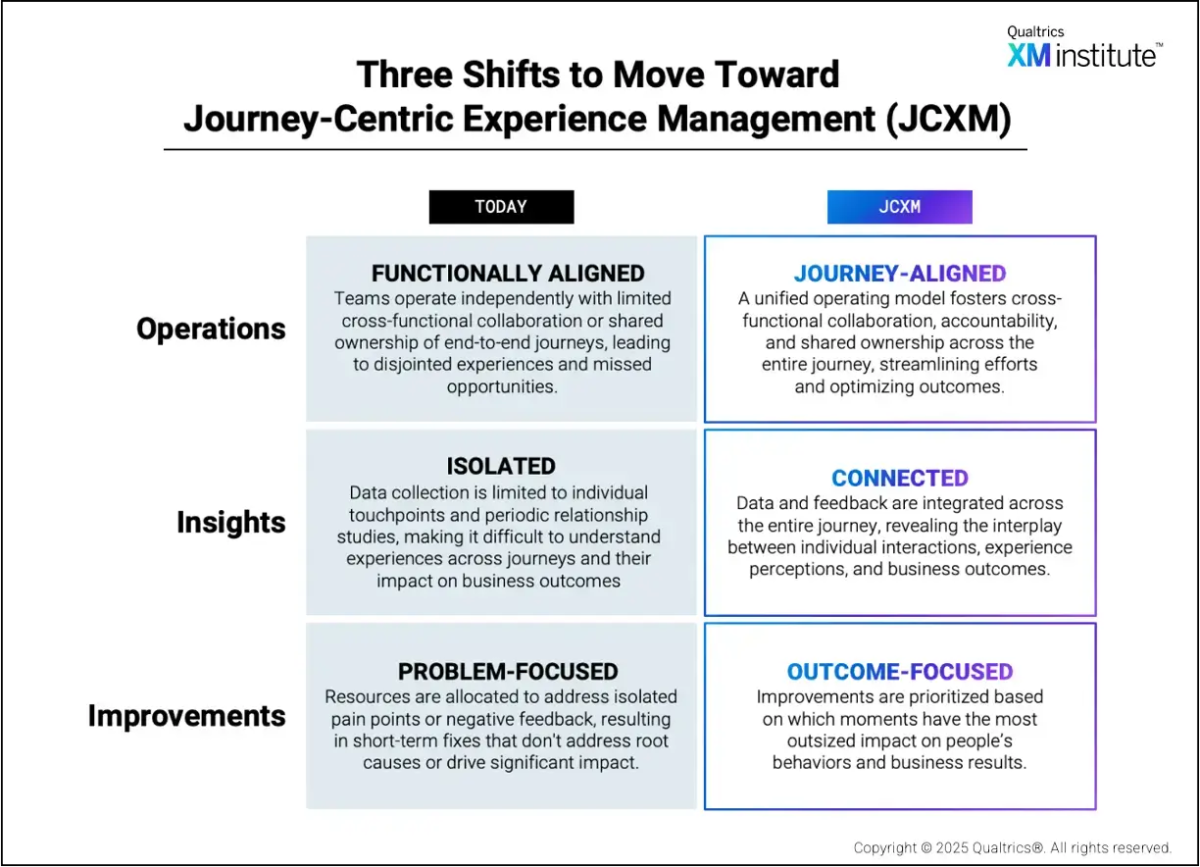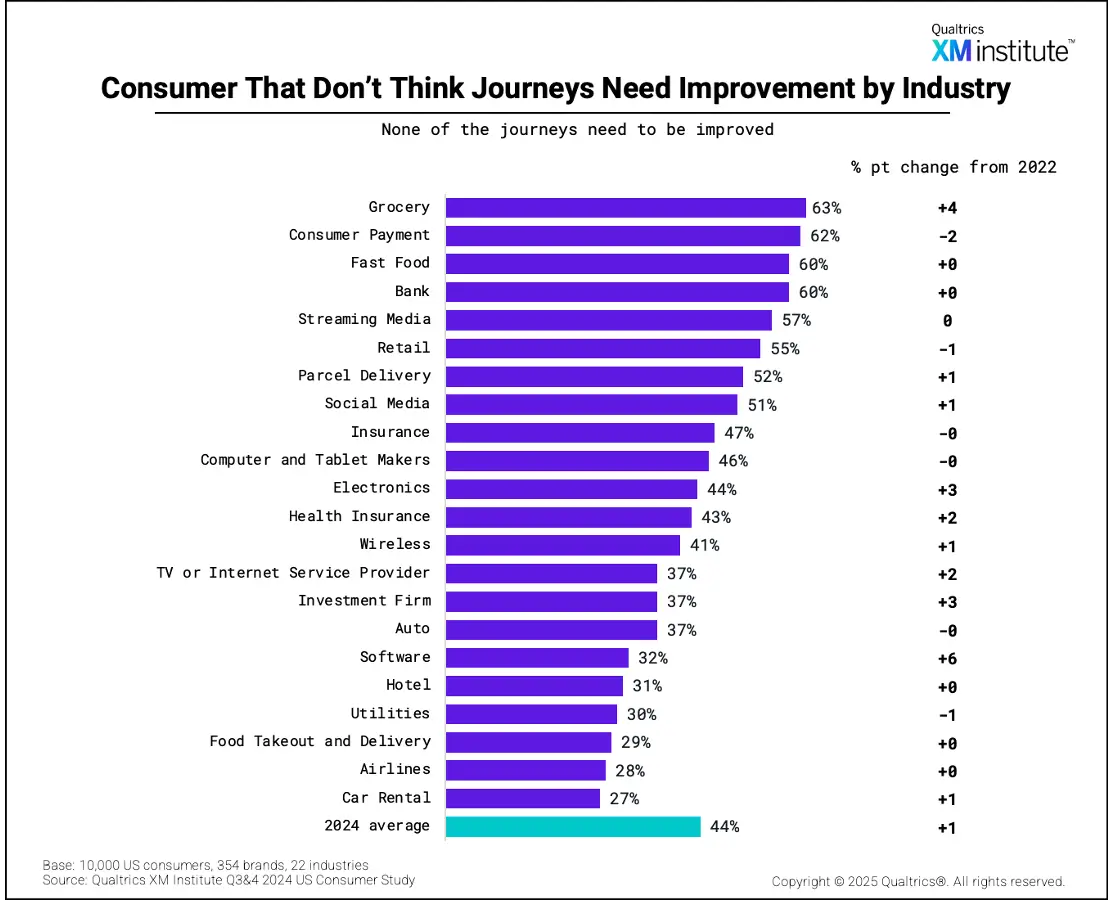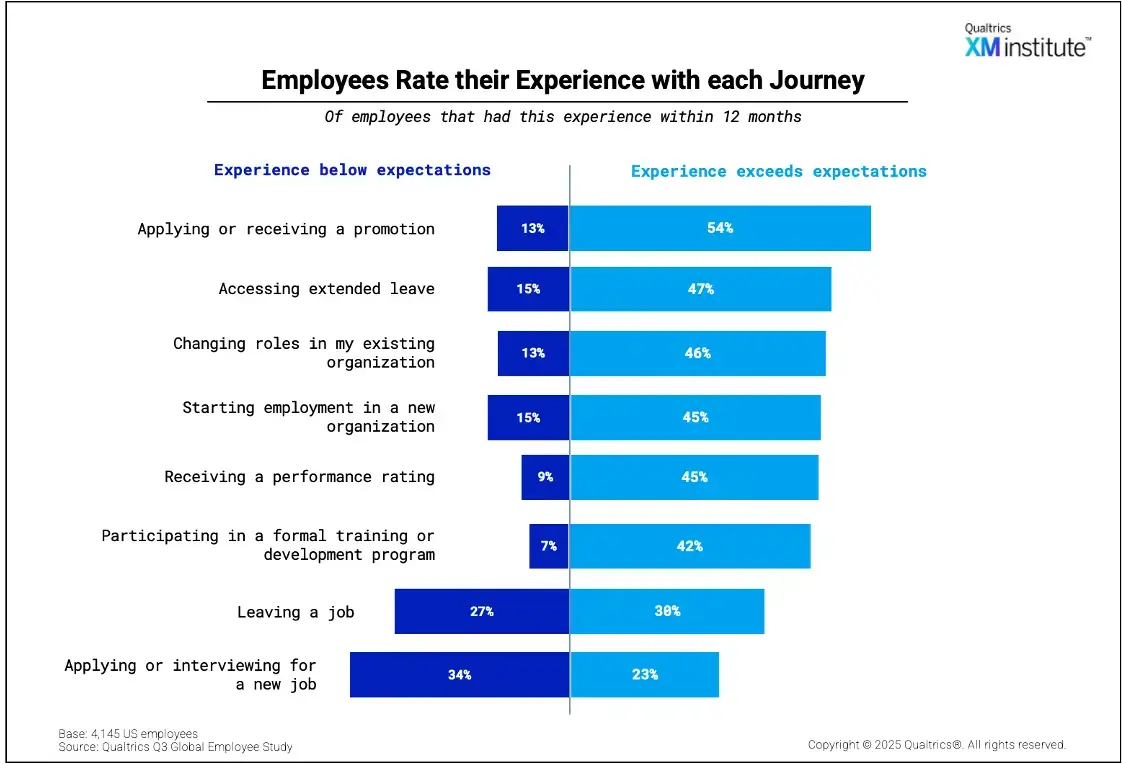Journeys provide a holistic view of an end-to-end experience that contextualizes individual interactions from the perspective of customers or employees rather than through the departmental silos that organizations typically align around. Shifting focus from improving isolated interactions and toward improvements that consider the end-to-end customer or employee journey allows organizations to better address people’s true needs and in turn creates an opportunity for greater long-term value.
But most organizations are not yet realizing the full potential of Journey-Centric Experience Management (JCXM), and are therefore more vulnerable to wasting the time and resources of both their XM program and their customers or employees.

One of the shifts organizations must make is to move from isolated to connected insights. This shift frequently involves bridging an "insights chasm," aka the gap between customer relationship measurements and specific interaction touchpoint feedback. Because of this gap, organizations often struggle to determine the importance of a particular touchpoint to a customer or employee and how it affects their overall relationship.
Adding journey metrics into this measurement system helps organizations address this gap – putting customers’ and employees’ interactions with different touchpoints in the context of their goals and insight into how specific interactions impact their overall relationship with the organization. With a system of connected insights, organizations can identify and prioritize improvements that will have the most impact on the outcomes their customers, employees, and stakeholders care about.
However, according to our recent research, just over half (51%) of CX programs are currently gathering journey feedback, compared with about three-quarters that conduct relationship tracking (75%) and collect interaction feedback (73%). Organizations that collect the latter listening elements but not the former miss a crucial piece of the customer experience and insights needed to understand how the interactions they deliver influence their overall customer relationship.
But establishing the listening elements and advanced analytical tools necessary to bridge this gap across the end-to-end customer or employee journey is no small feat. In this post, we share data on common painful journeys that may offer inspiration for practitioners looking to start improving the journey experiences they deliver.
Broken customer journeys across 22 US industries
In our recent report, Consumer Journeys Needing Improvement, 2025, we gauge which journeys seem to affect customer perceptions the most in each industry. In this study of 10,000 US consumers, we asked both the NPS (Net Promoter Score) question and for consumers to identify which–if any–journeys companies most need to improve.

In this analysis, we compared consumer NPS when no journeys are broken in each industry versus their 2025 industry average NPS, and found that:
- Consumers give a higher NPS when journeys aren’t broken. NPS is an average of 19 points higher when consumers don’t believe any journeys need improvement compared to the overall average industry NPS of 26. This difference is highest for airlines (30 pts) and lowest for social media (10 pts).
- Broken journeys are common. On average, consumers identified broken journeys more than half the time based on their experiences with specific companies. Getting help from customer service was the most commonly broken journey in seven of 22 industries.
- Not all broken journeys indicate disaster. Many journeys across industries seem to show little impact on NPS; for example, health insurance customers that say receiving useful updates could use improvement provide an NPS just 4 points lower than those that didn’t identify it as broken. Meanwhile, other journeys are much stronger predictors of poor customer relationships. Getting help from customer service most often corresponded with low NPS in 11 of 22 industries; TV/ISP consumers who identified this journey as broken provided an NPS 48 points lower.
US employees evaluate journeys
Compared to the variety of journeys that customers can experience with organizations, the list of employee journeys may be shorter but are no less important. Engaged employees work harder, go above and beyond expectations, and create better experiences for customers, all of which have downstream benefits on business outcomes. Understanding and making strategic improvements to employee journeys can propel an organization’s productivity and performance.

Qualtrics Q3 2024 employee study included responses from over 4,000 US employees about their recent experiences with several employee journeys. From their responses, we found that:
- Employee experience varies across journeys. The employee promotion journey most frequently impressed US employees – 54% considered this experience to exceed their expectations. Meanwhile, just 23% said the same about their experience applying or interviewing for a new job.
- Employers struggle with first and last impressions. Employees most often considered the candidate experience and the exit experience to be below expectations (34% and 27%, respectively). These crucial experiences can shape an organization’s relationship with potential future employees and customers alike.
Suggestions for practitioners
While we can’t tell you which journeys are the most frequent pain points for your customers or employees or which journeys have the largest impact on your business outcomes, we can provide context and direction to inform your next steps. The common issues that we’ve identified in this article and accompanying report can act as a starting point for your internal investigation. Here are some recommendations for XM professionals looking to take these insights to the next level:
- Understand your customer or employee journeys. Map the most important customer or employee journeys for your primary personas. A good way to get started: workshops with relevant stakeholders that map the steps your most important personas take to accomplish their objectives, the interactions they have along the way, and actions your organization takes – both directly and indirectly – to support their journey. Once you have solid drafts, validate the journey maps with customers or employees.
- Establish journey-level listening. To systematically improve the experiences you deliver, your interaction feedback and relationship metrics must be accompanied by journey metrics, which track how people view their interactions against the goal they are trying to achieve. This will help identify the most valuable improvement opportunities within a particular journey. Your listening portfolio should not only include experience data (e.g., satisfaction, effort), but also include operational data (demographics, retention rates) and behavioral data (click path, interaction history).
- Optimize your investments. Not all journeys are in need of improvement, and not all journeys are equally worth improving. Addressing and establishing listening mechanisms for the journeys you think most impact the business outcomes that matter most. With the right insights, you will be able to make data-driven decisions to resource the journeys that most impact organizational performance, and within those journeys pinpoint and improve the moments that matter the most.
The bottom line: Measuring and evaluating your customer and employee journeys is key to improving overall experiences.


